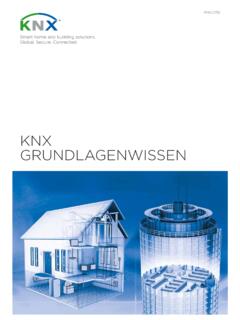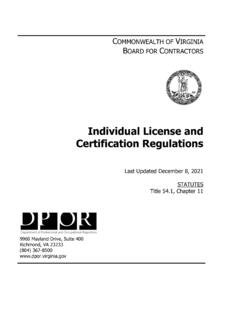Transcription of KNX BASICS
1 KNX BASICSS mart home and building solutions. Global. Secure. home and building solutions. Global. Secure. | The KNX Standard the basicsINTRODUCING BUS SYSTEMS Intelligent bus systems make buildings more cost-effective to operate, safer, more flexible, more energy-efficient and above all more comfortable and convenient. The KNX standard occupies a large share of the market for building automation , present and futurePeople live differently from how they did just a decade or two ago. We get money from cash dispensers, buy and sell goods and services over the internet, phone friends all over the world from our mobile phones, and start to moan if an MMS or e-mail takes more than 5 minutes to reach a destination in the USA.
2 In our cars we are guided around by sat navs, and we lock and unlock the doors remotely without a key. The interior light goes on the moment we step inside, then after a while slowly dims down again. In short, for quite some time we have been enjoy-ing cutting-edge developments in the areas of communication, entertainment and automotive technology. If we look at how technology in buildings has developed over the same period, it s a very different story. We still open our flat doors with conventional keys; and if we can t find our keys fast enough, the staircase light timer switches the lights off and plunges us into darkness. True, while we re out working all day, the heating automatically keeps our homes at a pleasant temperature but it doesn t notice whether we left the living room window open when we went out.
3 Only the electricity meter, ticking away quietly in a switch cabinet, notices that. Before going away for the weekend, it is wise to turn down the temperature in our hot water tanks and to turn off all those electrical appliances on standby. But no one actually does at least, not reliably. It takes too to do some catching up So electrical installations in buildings have some substantial catching up to do. Networked sensors and actuators have long since been a standard feature of motor cars; buildings, on the other hand, are lagging some way behind. A change of mindset is needed, not least because of the long service life of an elec-trical installation. Today s new buildings will have to adapt to numerous changes over the next few decades.
4 Now, more than ever, buildings need to be flexible and capable of accommodat-ing networked building services. In technical terms, all of this is already entirely feasible (Fig. 1).More networkingThe key to making a building intelligent is to equip it with networked sensors and actuators. There are several different ways of doing this: Conventional methods The immediately obvious solution is to employ a star topology, i. e. an arrangement where every socket outlet circuit, ceiling or wall outlet, and light switch is linked by its own (ideally five-core) NYM cable to a central distribution board in which the logical relationships are created by contactors, switch relays, and a programmable logic controller (PLC). This works well in reasonably small dwellings.
5 However, the size of the house only needs to increase by a fairly small amount before the extent of the wiring work and size of the power distribution boards required becomes excessive. In a star topology, adding to or extending the system is also very time-consuming in terms of installation and programming. Bus technologyA far better solution is to link all sensors and actuators in the building with a data cable , and enable them to share informa-tion with each other (Fig. 2). Each device can then communi-cate with every other device, for example: a light switch can talk to a dimmer and tell it how bright to set the ceiling light; a motion sensor can tell the actuator for the corridor lighting that someone has entered the corridor, or tell the room thermostat that there is no one in the room any more, so it can turn down the temperature.
6 Figure 1. Smart houses that adapt to users needs? It sounds like something from a sci-fi novel, but it is already a reality. Intelligent buildings incorporating networks of sophisticated devices that control the building as needed already exist, and are making life easier for their occupants on a day-to-day KNX Standard the BASICS | 3 Figure 2. A bus system is a system of sensors and actuators joined together by a bus cable .Examples of functional modules (may be self-contained or integrated in devices): Room temperature controllers Timer functions Freely-programmable logic modules PLCs with KNX interface Constant lighting control modules Alarming and alerting Telephone switchboards connected to the bus Media controlHeating controlPump controlPresence simulationDisplays and user interfaces Modules for connecting bus with telephone Modules for automatically sending warn-ing messages by text Modules for accessing building data from outside via the internet or a phone The following are examples of sensors that can send information to the bus.
7 Light switches Dimmer switches Motion sensors Presence detectors (which can detect whether there is a person in a room even if they are not moving) Window and door contacts (for security and heating control) Doorbell buttons for front doors Water, gas, electricity and heat meters Overvoltage sensors Temperature sensors for indoor and outdoor air Temperature sensors in heating and hot water circuits Modules for preselecting room temperature setpoints Brightness sensors for indoors and out-doors, for constant lighting control Wind sensors for controlling blinds Fault and system status messages for white goods (washing machine, clothes dryer, dishwasher, cooker, etc.) Leak sensors, e. g. in laundry room Level measurements e.
8 G. for rain water tank, oil tank, wood pellet store Radio receivers for door locks Receivers for infrared remote controls Fingerprint modules and card readers for access controlThe following are examples of actuators that can be controlled via the bus:Relays for switching room lights on and off Dimmers and DALI-gateways Electric thermostatic radiator valves Temperature displays Drive mechanisms for awnings, blinds, curtains and garage doors Drive mechanisms for windows Circulator pumps for heating systems Valve control systems, for solar thermal installations Alarms (lights and buzzers) Information displays and indicator LEDs Relays for making and breaking socket outlet circuits (standby cut-off) Well pumps Air conditioning systems Ventilation systems (toilet / bathroom extractor fans, controlled ventilation for living areas)
9 Control of washing machine, dryer, dishwasher Consumer electronics Trigger signals for alarm systems Telephone systems Electric door openers and door locking systems Smart home and building solutions. Global. Secure. | The KNX Standard the basicsWhy KNX?There are several bus technologies on the market. All of them are beneficial and appropriate for certain areas of application. But no other bus system is supported by as many different manufacturers as KNX. This is because: All strong brands in the building installation sector are pushing KNX technology KNX was developed specifically to meet the needs of electrical installations in buildings KNX devices are installed, programmed and parameterised by fully qualified system integrators KNX is well-established and can accommodate a huge range of functions There are several thousand KNX-certified product groups available, covering every conceivable field of application KNX products are tested for conformity by an independent third party test laboratories KNX products are compatible with products from all manufacturers (interworking)
10 End customers benefit from an extensive network of specialist tradesmen with solid KNX skills accredited by KNX-certified training centres The PC software ETS can be used to plan, design and commission installations of KNX-certified products from any manufacturer KNX supports all communication media: TP (based on a standalone 2-wire bus cable), PL (Powerline), RF (Radio Frequency), and IP / Ethernet / WLAN KNX is standardised in Europe, the USA, China and internationally, through e. g. CENELEC EN 50090 (Europe), EN ISO 22510 (Europe), ISO/IEC 14543-3 (International), GB/T 20965 (China), and ANSI/ASHRAE 135 (USA). More than 450 KNX members in 45 countries manufacture products according to the KNX standard.




